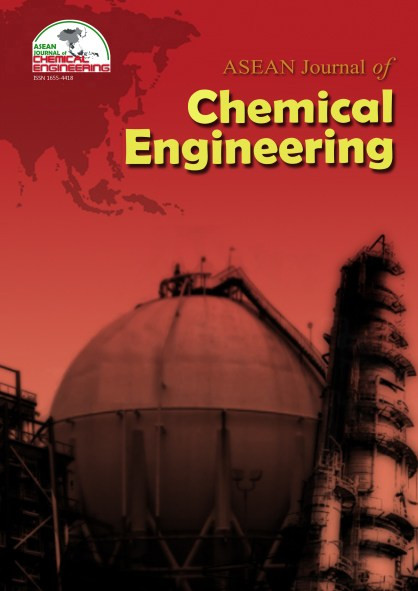The Optimization of Natural Gas Utilization Network in Single Region Using Pinch Analysis Method
Abstract
Natural gas is one of the cleanest energy resources and may have potency to replace crude oil as main energy resource in several decades. There are some aspects which must be concern in the development of the natural gas industry including processing, storing, distributing and utilizing of the natural gas. The network of natural gas supply also should be generated to obtain the maximum natural gas recovery. However, it is difficult to determine the most suitable network system to connect the supply and demand of natural gas due to their different time scale, flowrate and capacity. There are some studies which investigating the network system to connect the supply and demand of natural gas but there are no systematical method in determination of the optimum natural gas network in single region supply-chain using pinch analysis. Therefore, in this study, a systematical method was developed to design natural gas network system in single region (East Java) using pinch analysis. The concept of natural gas cascade calculation was introduced. The heuristics of natural gas pairing between source and sink streams in grid diagram analysis was developed. Using 0-year time minimum difference give the amount of unutilized supply with value of 258.4 billion standard cubic feet (BCF) while 3-year time minimum difference give the amount of alternative and unutilized supply with value of 639.3 BCF and 897.7 BCF, respectively. The grid diagram heuristics developed in this study gives same results with the cascade calculation result.
References
2. Al-Sobhi, S. A., Shaik, M. A., Elkamel, A., Erenay, F. S. (2018). Integrating Simulation in Optimal Synthesis and Design of Natural Gas Upstream Processing Networks. Ind. Eng. Chem. Res., 57, 5792–5804.
3. Copiello, S. (2018). Expansion of the Italian natural gas network to the Sardinia Island: Economic assessment. J. Nat. Gas Sci. Eng., 54, 297–308.
4. Farzaneh-Gord, M., and Rahbari, H. R. (2018). Response of natural gas distribution pipeline networks to ambient temperature variation (unsteady simulation). J. Nat. Gas Sci. Eng., 52, 94–105.
5. Foo, D. C. Y., Kazantzi, V., El-Halwagi, M. M., Manan, Z. A. (2006). Surplus diagram and cascade analysis technique for targeting property-based material reuse network. Chem. Eng. Sci., 61, 2626–2642.
6. Karimi, I. A., and Khan, M. S. (2018). Special Issue on PSE Advances in Natural Gas Value Chain: Editorial. Ind. Eng. Chem. Res., 57, 5733–5735.
7. Liang, F.-Y., Ryvak, M., Sayeed, S., Zhao, N. (2012). The role of natural gas as a primary fuel in the near future, including comparisons of acquisition, transmission and waste handling costs of as with competitive alternatives. Chem. Cent. J., 6, S4.
8. Linnhoff, B., and Hindmarsh, E. (1983). The pinch design method for heat exchanger networks. Chem. Eng. Sci., 38, 745–763.
9. Ministry of Energy and Mineral Resource of Indonesia. (2018). Natural Gas Balance in Indonesia: 2018-2027. Jakarta.
10. Nandari, W. W., Prasetyo, I., Fahrurrozi, M. (2016). Thermodynamics analysis on methane hydrate formation in porous carbon. ASEAN J. Chem. Eng., 16, 8–20.
11. Ooi, R. E. H., Foo, D. C. Y., Ng, D. K. S., Tan, R. R. (2012). Graphical Targeting Tool for the Planning of Carbon Capture and Storage. Chem. Eng. Trans., 29, 415–420.
12. Putra, A. A., Juwari, Handogo, R. (2018). Multi Region Carbon Capture and Storage Network in Indonesia Using Pinch Design Method. Process Integr. Optim. Sustain., 2, 321–341.
13. Singhvi, A., and Shenoy, U. V. (2002). Aggregate Planning in Supply Chains by Pinch Analysis. Chem. Eng. Res. Des., 80, 597–605.
14. Tan, S. H., and Barton, P. I. (2015). Optimal dynamic allocation of mobile plants to monetize associated or stranded natural gas, Part I: Bakken shale play case study. Energy, 93, 1581–1594.
15. Tan, S. H., and Barton, P. I. (2016). Optimal dynamic allocation of mobile plants to monetize associated or stranded natural gas, part II: Dealing with uncertainty. Energy, 96, 461–467.
16. Wang, P., Yu, B., Han, D., Sun, D., Xiang, Y. (2018). Fast method for the hydraulic simulation of natural gas pipeline networks based on the divide-and-conquer approach. J. Nat. Gas Sci. Eng., 50, 55–63.
Copyright holder for articles is ASEAN Journal of Chemical Engineering. Articles published in ASEAN J. Chem. Eng. are distributed under a Creative Commons Attribution-NonCommercial 4.0 International (CC BY-NC 4.0) license.
Authors agree to transfer all copyright rights in and to the above work to the ASEAN Journal of Chemical Engineering Editorial Board so that the Editorial Board shall have the right to publish the work for non-profit use in any media or form. In return, authors retain: (1) all proprietary rights other than copyright; (2) re-use of all or part of the above paper in their other work; (3) right to reproduce or authorize others to reproduce the above paper for authors’ personal use or for company use if the source and the journal copyright notice is indicated, and if the reproduction is not made for the purpose of sale.



